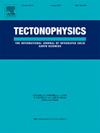Crustal and uppermost mantle S-velocity structure of the Seoul metropolitan area on the Korean Peninsula from Helmholtz tomography
IF 2.7
3区 地球科学
Q2 GEOCHEMISTRY & GEOPHYSICS
引用次数: 0
Abstract
The Seoul metropolitan area, the most densely populated part of the Korean Peninsula, features complex subsurface structures and seismogenic faults, though their characteristics remain ambiguous due to low seismicity and limitations in fault investigation. High-resolution velocity models can provide constraints for identifying subsurface faults by detecting elongated low-velocity anomalies along fault zones. Recently, a dense seismic network was deployed in this area, facilitating the use of Helmholtz tomography, an array-based method that accounts for finite-frequency effects. Utilizing Helmholtz tomography, we obtained a high-resolution S-wave velocity model down to a depth of 50 km with waveform data recorded at 74 broadband seismic stations. We found that a linear low-velocity anomaly along the Pocheon fault extends to the uppermost mantle, with an increasing width with depth. In contrast, the Dongducheon fault, which traverses Seoul from north to south, is not well imaged, indicating its current weak activity. Another linear low-velocity anomaly extends southwest through Seoul from northern Seoul, potentially representing the extension of the Pocheon fault based on similar strike and dip directions. Additionally, a large lateral low-velocity anomaly is identified in the lower crust beneath the northern part of the Seoul metropolitan area, interpreted as a ductile décollement, connected with the Pocheon, Wangsukcheon, and possibly Gyeonggang faults. This study successfully identified the extensions and orientations of subsurface faults beneath the Seoul metropolitan area down to the uppermost mantle, which is critical for seismic hazard predictions and earthquake simulations in this highly populated area.
通过亥姆霍兹断层扫描研究朝鲜半岛首尔都市圈的地壳和最上层地幔 S-速度结构
首尔大都市区是朝鲜半岛人口最稠密的地区,具有复杂的地下结构和地震断层,但由于地震发生率低和断层调查的局限性,其特征仍然模糊不清。高分辨率速度模型可以通过探测沿断层带拉长的低速度异常,为识别地下断层提供约束条件。最近,在这一地区部署了密集的地震网络,为使用亥姆霍兹层析成像法提供了便利,这是一种基于阵列的方法,考虑到了有限频率效应。利用亥姆霍兹层析成像法,我们利用 74 个宽带地震台站记录的波形数据,获得了深度达 50 千米的高分辨率 S 波速度模型。我们发现,波川断层沿线的线性低速度异常一直延伸到最上层地幔,宽度随深度增加而增大。相比之下,从北到南横穿首尔的东都川断层没有得到很好的成像,这表明其目前的活动性较弱。另一个线性低速异常从首尔北部向西南延伸穿过首尔,根据相似的走向和倾角方向,可能代表了抱川断层的延伸。此外,在首尔市区北部地壳下部还发现了一个大的横向低速异常,被解释为与浦川断层、王水川断层以及可能的京江断层相连的韧性断层。这项研究成功地确定了首尔市区地下直至最上地幔的地下断层的延伸和走向,这对这一人口密集地区的地震灾害预测和地震模拟至关重要。
本文章由计算机程序翻译,如有差异,请以英文原文为准。
求助全文
约1分钟内获得全文
求助全文
来源期刊

Tectonophysics
地学-地球化学与地球物理
CiteScore
4.90
自引率
6.90%
发文量
300
审稿时长
6 months
期刊介绍:
The prime focus of Tectonophysics will be high-impact original research and reviews in the fields of kinematics, structure, composition, and dynamics of the solid arth at all scales. Tectonophysics particularly encourages submission of papers based on the integration of a multitude of geophysical, geological, geochemical, geodynamic, and geotectonic methods
 求助内容:
求助内容: 应助结果提醒方式:
应助结果提醒方式:


